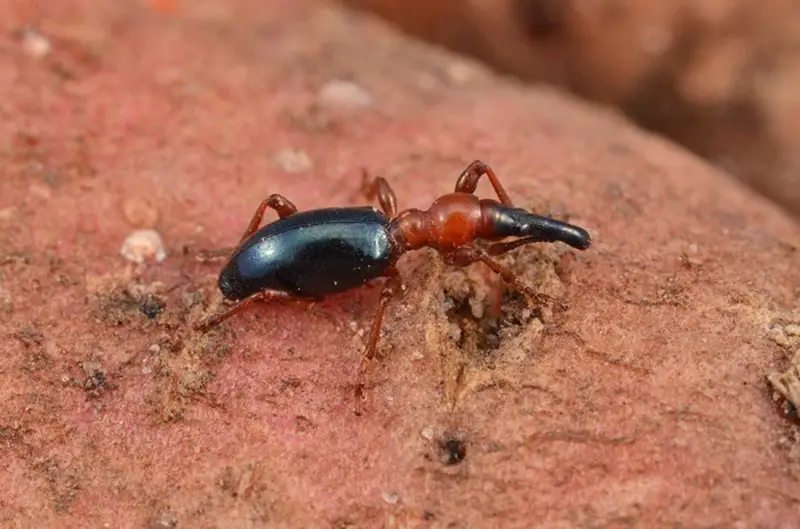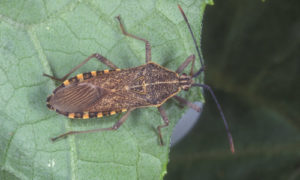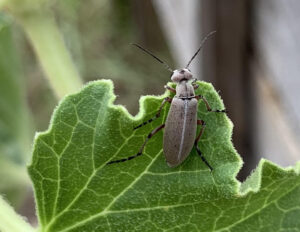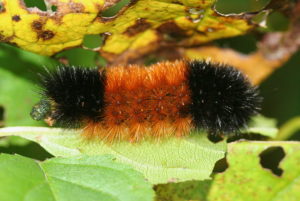The sweet potato weevil poses a serious threat to members of the Convolvulaceae family, including morning glories and sweet potatoes. Weevils are a threat to the latter because they consume leaves and tunnel into the root vegetable, which can cause the tuber (sweet potato) to have a foul odor and bitter taste.
Sweet potato weevils were first observed in the United States in the late 19th century. While common in Louisiana, Florida, North Carolina, and Texas, they are a problem all over the world.
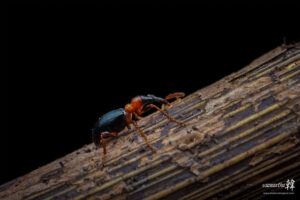
How to Identify the Sweet Potato Weevil
The adult sweet potato weevil (Cylas formicarius) has a shiny, ant-like body with a rostrum or snout. The prothorax, that is, the middle of the body, along with the legs, is orange to reddish-brown, while the rest of the body is metallic blue to black. It measures approximately 1/4 to 1/3 inch (6.5 to 8.0 mm) in length. Adults have wings and can fly short distances but seldom do.
Adult weevils can be found feeding on the stems and the underside of leaves as well as tunneling into the roots or sweet potatoes. They are usually more active in the evening when it is dark. If discovered, they may “play possum” and act like they are dead. Weevils target vines earlier in the season and tubers later in the season.
The larvae have a white-gray, somewhat elongated soft body that measures about 3/8 inch (9.5 mm) long and curls into a slight “C” shape. They also have a head capsule that is yellow-brown. They can often be found feeding in tunnels in the tuber.
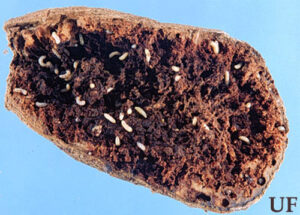
The yellow-white oval eggs, while only about 0.7 mm in length and 0.5 mm in width, are often located in small cavities or holes at the base of vines or in sweet potatoes. The cavities are sealed with excrement by the adult female laying the eggs.
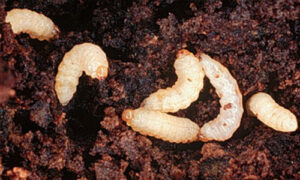
Characteristic Damage
Unless there is a heavy infestation, damage from sweet potato weevils may not be visible until the tubers have been harvested. At other times, however, their presence can be deduced by observing damaged foliage. Here are some of the tell-tale signs that occur both above and below the soil to help you determine if the culprit is the sweet potato weevil.
- Chewed leaf edges and surfaces and small holes in leaves
- Dry, yellow to brown or wilting foliage
- Yellowing, thickened, or malformed vines
- Weakened stems and vines with or without signs of chewing
- Roots or tubers with signs of chewing, holes, tunneling
- Spongy tubers with brown or black spots
- Sweet potatoes may have a foul odor and bitter taste
- Sweet potato black rot – weevils are a vector for this fungal disease
- Weevils may hide in stored potatoes, not just newly harvested ones
- Pulled plants may have root rot
- Eggs, larvae, or adult weevils in stems, vines, roots, or tubers
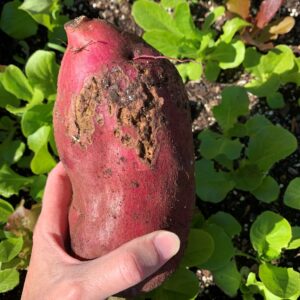
Life Cycle
An adult female weevil will deposit two to four eggs per day in plant stems near the soil level. Alternatively, she may crawl through cracks in the soil to access the sweet potatoes where she will hollow out cavities in the root vegetable and deposit one egg per cavity. She will then seal each cavity by plugging it with her fecal matter.
One to two weeks later, the larva will hatch and burrow into the stem or sweet potato, where it will go through three instars or stages. The larval stages are the most destructive period as it feeds on stems, roots, and sweet potatoes. One generation takes approximately four to six weeks to develop, and one growing season can see as many as eight generations.
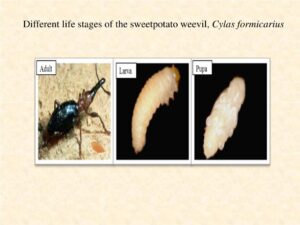
As the larva feeds, it will, like the adult, create tunnels, which will then become packed with its excrement. When the larva reaches the pupa stage, it will turn grayer in color. It will create a cavity in which it will pupate for about seven to ten days. This stage could last up to four weeks if the weather is cool. An adult weevil will emerge from its pupation chamber by chewing a hole in the stem, or if it has pupated in the sweet potato, it will remain there and feed.
The complete life cycle can take about one to two months to complete.
This article contains affiliate links. If you make a purchase using one of these links, I will receive a very small commission at no additional cost to you, and it will help me maintain this website. Rest assured, I only recommend products I actually like!
How to Treat
The following is a list of treatment options:
- Texas A&M University’s AgriLife Extension lists azadirachtin, the natural ingredient found in neem oil, as an organic insecticidal control for sweet potato weevils. Azadirachtin is found in the organic neem oil that I use and recommend. Spray the foliage with the DIY recipe listed here. Note it will only kill the adult weevils because it does not reach the tunneling larvae. Nevertheless, if adults are eliminated, by extension, there will be a reduction in the number of eggs and larvae.
- Others suggest a neem oil drench or neem oil pellets to control larvae in the soil.
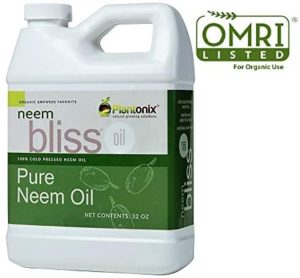
- AgriLife Extension also lists garlic juice extract as an organic treatment.
- Some suggest putting cut sweet potatoes out as a trap. If you opt for this method, be sure to inspect the cut potatoes and discard them frequently.
- Summer savory is used by some as a companion plant. It is said to confuse and possibly repel the adult weevil.
- Natural predators include wasps, ants, and brown earwigs. In addition, entomopathogenic nematodes, which are soft-bodied roundworms, are a natural enemy of the sweet potato weevil larvae.
- Several strains of entomopathogenic nematodes appear to suppress sweet potato weevils by penetrating the soil and killing larvae.
- Beauveria bassiana, an entomopathogenic fungus used to control sweet potato weevils and other insects, is a method some choose. Insects become infected when they come into contact with the spores, which rapidly grow inside the host, ending in its death. A word of caution, however, if you opt for Beauveria bassiana. Although it is said that Beauveria bassiana does not generally infect humans, it may exacerbate problems for those who have difficulty breathing. In addition, there has been at least one case of human infection in someone with suppressed immunity. Regarding animals, studies document where an American alligator, tortoises, and reptiles have been negatively impacted by the fungal pathogen. Personally, I would not use Beauveria bassiana. If, however, you choose to, exercise caution and follow directions on package.
- If you already have an infestation, remember that morning glories also attract weevils, thus you will need to address the issue there as well.
How to Prevent
Even though this tuber pest is problematic, there are things you can do to prevent an infestation. Here are some suggestions:
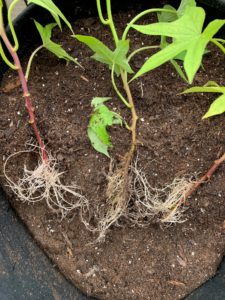
- Grow your own sweet potato slips from healthy potatoes or purchase slips that are certified to be free from weevils.
- Mulch beds and containers so that any cracks or openings in the soil will be covered, minimizing the weevils’ access to roots and potatoes. Be sure to cover the base of the plant as well to prevent females from laying their eggs there.
- Practice crop rotation so that any weevils, larvae, or eggs in the soil will not have their preferred food. Do not plant sweet potatoes or other crops from the same family in the same location two years in a row.
- Keep garden beds and containers free from weeds and plant debris. Remove any sweet potato plant cuttings after harvest. Do not mulch, as most compost piles do not maintain high enough heat to kill the eggs.
- Some suggest sprinkling ash on top of the potato plant to act as a barrier. Any weevils coming in contact with the ash will die. Note that too much ash or repeated applications in the same area can alter the pH of the soil and affect nutrient uptake.
Sweet potato weevils do not have to destroy your crops. You now have the information and tools to remedy or prevent the problem.
Thank you for reading this article! If you found it interesting or helpful, please consider sharing it with others via email and social media!
